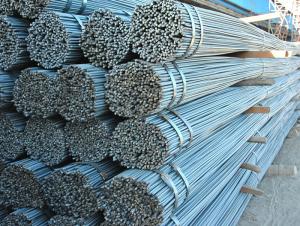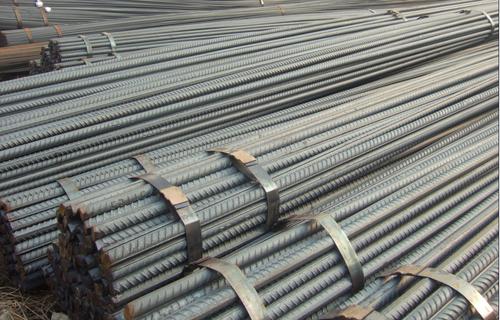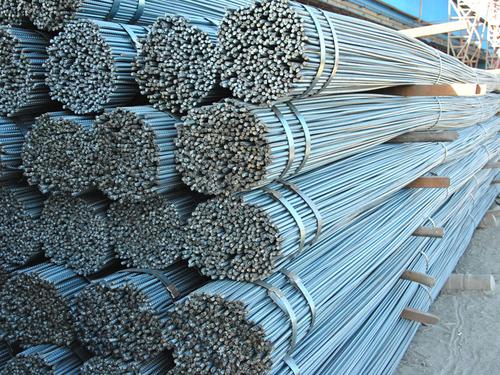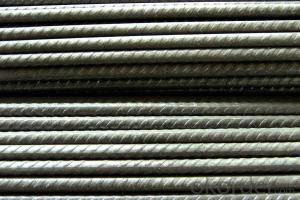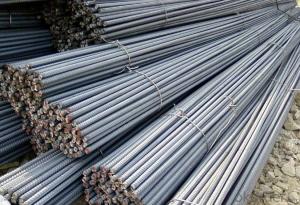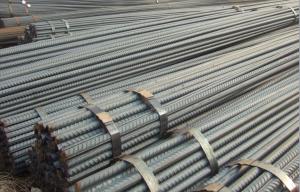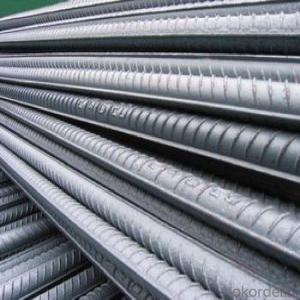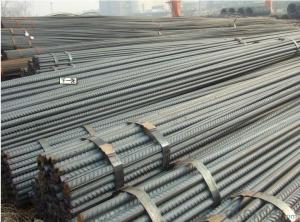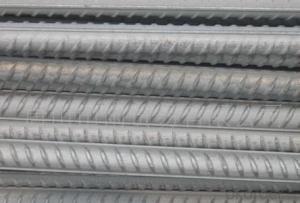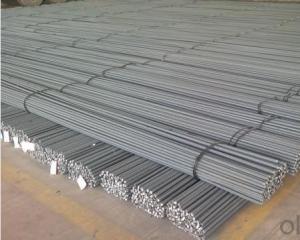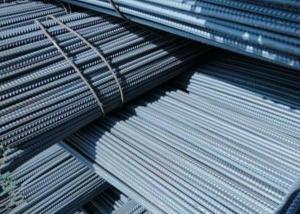Deformed Steel Bar 6mm-50MM ASTM A615 Or BS4449
- Loading Port:
- China Main Port
- Payment Terms:
- TT or LC
- Min Order Qty:
- -
- Supply Capability:
- -
OKorder Service Pledge
OKorder Financial Service
You Might Also Like
Product Description:
OKorder is offering Deformed Steel Bar 6mm-50MM ASTM A615 Or BS4449 at great prices with worldwide shipping. Our supplier is a world-class manufacturer of steel, with our products utilized the world over. OKorder annually supplies products to European, North American and Asian markets. We provide quotations within 24 hours of receiving an inquiry and guarantee competitive prices.
Product Applications:
Deformed bar is widely used in buildings, bridges, roads and other engineering construction. Big to highways, railways, bridges, culverts, tunnels, public facilities such as flood control, dam, small to housing construction, beam, column, wall and the foundation of the plate, deformed bar is an integral structure material. With the development of world economy and the vigorous development of infrastructure construction, real estate, the demand for deformed bar will be larger and larger
Product Advantages:
OKorder's Deformed Steel Bar 6mm-50MM ASTM A615 Or BS4449 are durable, strong, and resist corrosion, exact size, regular package, chemical and mechanical properties are stable.
Main Product Features:
· Premium quality
· Prompt delivery & seaworthy packing (30 days after receiving deposit)
· Corrosion resistance
· Can be recycled and reused
· Mill test certification
· Professional Service
· Competitive pricing
Product Specifications:
Manufacture: Hot rolled
Grade: BS4449
Certificates: ISO, SGS, BV, CIQ
Diameter: 6mm,8mm,10mm,12mm,14mm,16mm,18mm,20mm,
22mm,25mm,28mm,32mm,36mm,40mm,50mm
Length: 6M, 9M,12M or as required
Packaging: Export packing, nude packing, bundled
Chemical Composition: (Please kindly find our chemistry of our material based on HRB500 as below for your information)
Grade | Technical data of the original chemical composition (%) | ||||||
C | Mn | Si | S | P | V | ||
HRB400 | ≤0.25 | ≤1.60 | ≤0.80 | ≤0.045 | ≤0.045 | 0.04-0.12 | |
Physical capability | |||||||
Yield Strength (N/cm²) | Tensile Strength (N/cm²) | Elongation (%) | |||||
≥400 | ≥570 | ≥14 | |||||
Theoretical weight and section area of each diameter as below for your information:
Diameter(mm) | Section area (mm²) | Mass(kg/m) | Weight of 12m bar(kg) |
6 | 28.27 | 0.222 | 2.664 |
8 | 50.27 | 0.395 | 4.74 |
10 | 78.54 | 0.617 | 7.404 |
12 | 113.1 | 0.888 | 10.656 |
14 | 153.9 | 1.21 | 14.52 |
16 | 201.1 | 1.58 | 18.96 |
18 | 254.5 | 2.00 | 24 |
20 | 314.2 | 2.47 | 29.64 |
22 | 380.1 | 2.98 | 35.76 |
25 | 490.9 | 3.85 | 46.2 |
28 | 615.8 | 4.83 | 57.96 |
32 | 804.2 | 6.31 | 75.72 |
36 | 1018 | 7.99 | 98.88 |
40 | 1257 | 9.87 | 118.44 |
50 | 1964 | 15.42 | 185.04 |
FAQ:
Q1: How do we guarantee the quality of our products?
A1: We have established an advanced quality management system which conducts strict quality tests at every step, from raw materials to the final product. At the same time, we provide extensive follow-up service assurances as required.
Q2: How soon can we receive the product after purchase?
A2: Within three days of placing an order, we will begin production. The specific shipping date is dependent upon international and government factors, but is typically 7 to 10 workdays.
Q3: What makes stainless steel stainless?
A3: Stainless steel must contain at least 10.5 % chromium. It is this element that reacts with the oxygen in the air to form a complex chrome-oxide surface layer that is invisible but strong enough to prevent further oxygen from "staining" (rusting) the surface. Higher levels of chromium and the addition of other alloying elements such as nickel and molybdenum enhance this surface layer and improve the corrosion resistance of the stainless material.
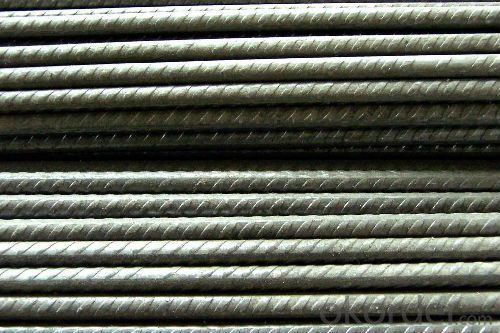
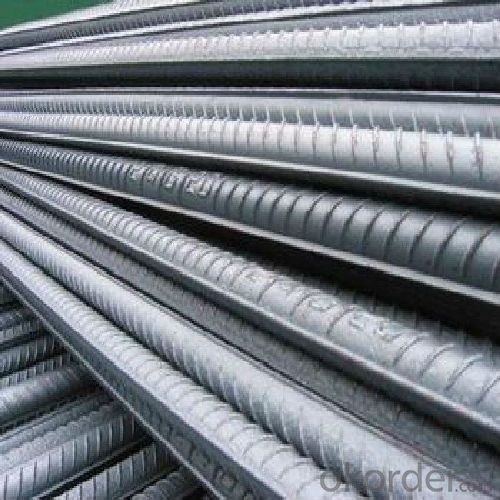
- Q: What are the safety precautions to be taken while handling steel rebars?
- When handling steel rebars, it is important to follow several safety precautions. First and foremost, proper personal protective equipment (PPE) should be worn, including gloves, safety glasses, and steel-toed boots. This will help protect against potential injuries and hazards. Additionally, it is crucial to lift and carry rebars using proper lifting techniques and equipment, such as using cranes or forklifts, as rebars can be heavy and awkward to handle. Workers should also be cautious of sharp edges or protruding ends of rebars and ensure they are properly capped or covered. Lastly, it is essential to maintain a clean and organized work area, removing any obstacles or tripping hazards to prevent accidents.
- Q: What are the guidelines for the proper installation of steel rebars?
- The proper installation of steel rebars is crucial for ensuring the structural integrity and durability of reinforced concrete structures. Here are some guidelines to follow for their proper installation: 1. Planning and Design: Before beginning the installation, it is important to have a detailed plan and design in place. This includes determining the required rebar size, spacing, and configuration based on the structural requirements and specifications. Consulting structural engineers and adhering to local building codes and regulations is essential. 2. Cutting and Bending: Rebars should be cut and bent accurately according to the design specifications. Proper tools such as rebar cutters and benders should be used to ensure clean cuts and precise bends. Any damaged or corroded rebars should be discarded and replaced. 3. Cleaning and Preparation: The surface of the rebars must be free from any contaminants like rust, oil, dirt, or loose scales before installation. Cleaning the rebars using wire brushes or air blasting is recommended to ensure proper adhesion between the rebar and concrete. 4. Placement and Positioning: The rebars should be placed and positioned accurately as per the design drawings. They should be securely tied or supported using tie wires or rebar chairs to maintain the desired spacing and alignment. Splices should be made in accordance with the design requirements and properly lapped to ensure continuity and strength. 5. Concrete Cover: The rebars should be adequately covered with concrete to protect them from corrosion and provide fire resistance. The concrete cover thickness should meet the design specifications and local building codes. Proper spacing between rebars and formwork should be maintained to allow proper concrete flow and consolidation. 6. Anchorage and Embedment: Adequate anchorage and embedment of rebars are essential for transferring loads and ensuring structural stability. Special care should be taken to provide proper hooks, bends, or mechanical anchorage at the ends of rebars as per the design requirements. The rebars should be properly embedded into the adjacent concrete elements to achieve the desired bond strength. 7. Inspection and Quality Control: Regular inspection should be carried out during the installation process to ensure compliance with the design specifications and quality standards. Any deviations or defects should be identified and rectified promptly. It is important to document the installation process and maintain proper records for future reference. By following these guidelines, the proper installation of steel rebars can be achieved, ensuring the structural strength, longevity, and safety of reinforced concrete structures.
- Q: How do steel rebars affect the overall acoustic properties of a structure?
- The overall acoustic properties of a structure are greatly affected by steel rebars, also known as reinforcement bars. Steel rebars can have both positive and negative effects on the acoustic characteristics of a building or infrastructure. One way in which steel rebars impact the acoustic properties is through their ability to transmit sound vibrations. Steel, being a good conductor of sound, easily allows sound waves to travel. Consequently, when steel rebars are present in a structure, they act as pathways for sound transmission, allowing it to easily travel throughout the building. This can result in increased noise levels and reduced acoustic privacy, as sound waves can travel through the steel rebars and reach different areas of the structure. However, steel rebars can also contribute to the overall sound insulation of a structure. When properly installed and integrated with other construction materials like concrete or acoustic insulation materials, steel rebars help reduce the transmission of sound waves. The stiffness and mass of steel rebars help dampen the vibrations caused by sound waves, thereby reducing the amount of sound that passes through the structure. This enhances the acoustic comfort within the building, creating a quieter environment suitable for various activities that require reduced noise levels. It is important to note that the impact of steel rebars on the acoustic properties of a structure depends on various factors, including the thickness and density of the surrounding construction materials, the arrangement and spacing of the rebars, and the overall design of the building. Additionally, the use of additional acoustic treatments like sound-absorbing panels or insulation can further improve the acoustic performance of a structure by mitigating the negative effects of steel rebars. In conclusion, steel rebars play a significant role in the overall acoustic properties of a structure. While they can facilitate the transmission of sound waves, they can also contribute to sound insulation when combined with appropriate construction materials and techniques. Proper design and implementation, along with the use of additional acoustic treatments, are crucial in achieving the desired acoustic environment in buildings and infrastructure where steel rebars are present.
- Q: How are steel rebars used in the construction of tunnels and underground passages?
- Steel rebars are an essential component in the construction of tunnels and underground passages. These rebars, also known as reinforcing bars, are used to provide additional strength and stability to the concrete structure. In tunnel construction, rebars are placed strategically within the concrete to reinforce it and prevent cracking or collapsing. The rebars act as a skeleton for the concrete, distributing the load and reinforcing its structural integrity. They are typically arranged in a grid pattern throughout the tunnel walls, floor, and ceiling. One of the key reasons why rebars are used in tunnel construction is their ability to withstand tension forces. Tunnels are subjected to significant pressure from the surrounding soil and water, and without proper reinforcement, the concrete would easily crack under this pressure. By adding steel rebars, the tensile strength of the concrete is greatly increased, ensuring that it can withstand the external forces acting upon it. Moreover, rebars also help to control and prevent the propagation of cracks. In the event of a crack occurring, the rebars act as a barrier, preventing the crack from spreading throughout the structure. This is crucial in tunnels and underground passages as any weakening of the concrete could compromise the safety of the structure and those using it. Additionally, rebars are used to reinforce specific areas of the tunnel that are more prone to stress, such as corners, joints, and areas where heavy equipment or vehicles may pass through. By reinforcing these critical points with steel rebars, the overall structural integrity of the tunnel is significantly enhanced. Overall, the use of steel rebars in the construction of tunnels and underground passages is vital to ensure the strength, stability, and longevity of these structures. They play a crucial role in preventing cracking, controlling the propagation of cracks, and enhancing the overall durability of the concrete.
- Q: What are the common manufacturing processes for steel rebars?
- The common manufacturing processes for steel rebars include hot rolling, cold rolling, and thermomechanical treatment.
- Q: How do steel rebars affect the maintenance requirements of a structure?
- Steel rebars can significantly impact the maintenance requirements of a structure by enhancing its structural integrity and durability. The use of steel rebars in concrete structures helps prevent cracking, improve load-bearing capacity, and enhance resistance against external forces such as earthquakes and weathering. As a result, the maintenance requirements of the structure are reduced as it becomes more resilient to wear and tear, reducing the need for frequent repairs or replacements.
- Q: What is the cost of steel rebars compared to other construction materials?
- The cost of steel rebars is generally higher compared to other construction materials due to its durability, strength, and longevity. However, it is important to consider the specific project requirements, as cost can vary depending on the market and availability of alternative materials.
- Q: Are there any codes or regulations for the use of steel rebars in construction?
- Steel rebars in construction are subject to codes and regulations to ensure their proper use. Guidelines and standards are provided by organizations like the American Concrete Institute (ACI) in the United States. The ACI 318 Building Code Requirements for Structural Concrete outlines specific requirements for the size, placement, and quality of rebars. Similar regulations can be found in the widely adopted International Building Code (IBC), which governs construction practices in different jurisdictions. It includes provisions and references to standards that dictate the use of rebars in reinforced concrete structures. Different countries also have their own standards organizations, such as the British Standards Institution (BSI) in the United Kingdom. These organizations have their own codes and regulations for the use of rebars in construction. These codes and regulations are crucial for ensuring the safety and longevity of structures. They establish requirements for rebars' size, grade, and placement, as well as provide guidelines for designing, detailing, and constructing reinforced concrete elements. Adhering to these codes and regulations guarantees that structures can withstand anticipated loads and perform as intended.
- Q: How do steel rebars impact the overall cost of a construction project?
- Steel rebars can have a significant impact on the overall cost of a construction project. While they add to the material costs, they also enhance the strength and durability of structures, reducing the need for future repairs or replacements. Additionally, steel rebars contribute to the overall efficiency and speed of construction, reducing labor costs and project timelines. Therefore, although they may increase upfront expenses, steel rebars can provide long-term cost savings and ensure the structural integrity of the project.
- Q: What is the role of steel rebars in minimizing the risk of progressive collapse?
- Steel rebars play a critical role in minimizing the risk of progressive collapse by providing structural reinforcement and enhancing the load-bearing capacity of a building or structure. They are embedded within concrete elements such as beams, columns, and slabs, creating a composite structure that can resist higher loads and distribute them evenly. In the event of a localized failure or an unexpected load, rebars help prevent the collapse from propagating further by transferring the load to other intact elements, thereby preventing a catastrophic failure. Overall, steel rebars contribute to the structural integrity and resilience of a building, reducing the risk of progressive collapse.
Send your message to us
Deformed Steel Bar 6mm-50MM ASTM A615 Or BS4449
- Loading Port:
- China Main Port
- Payment Terms:
- TT or LC
- Min Order Qty:
- -
- Supply Capability:
- -
OKorder Service Pledge
OKorder Financial Service
Similar products
Hot products
Hot Searches
Related keywords


